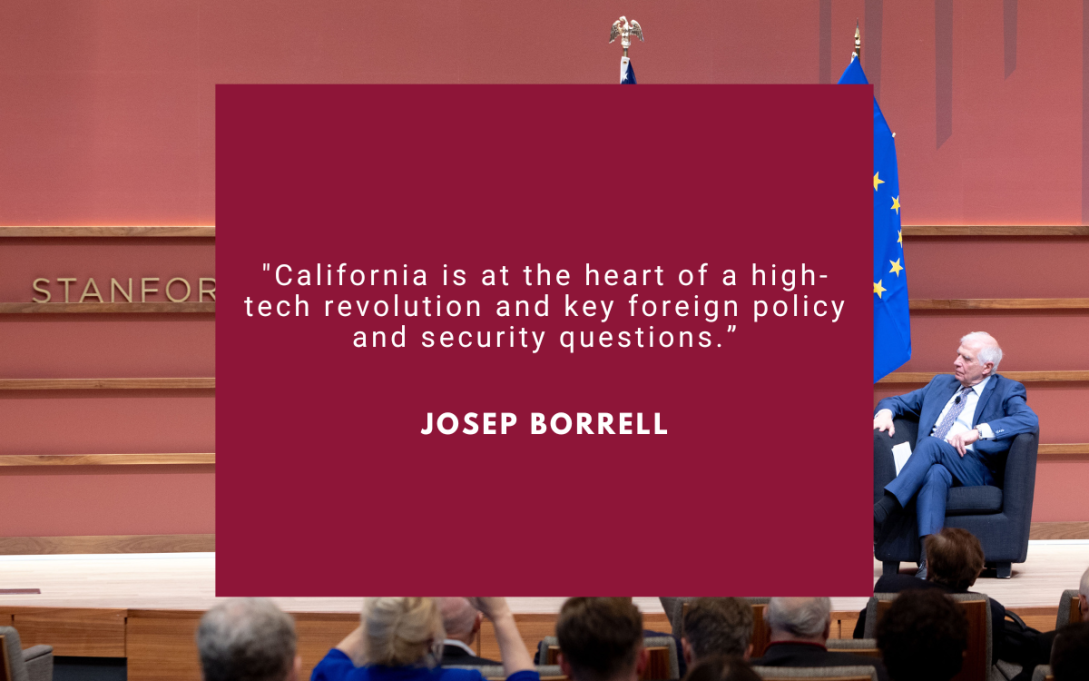Three lessons from California

Last week, I was in California to explore the intersection between rapid technological developments and key foreign policy and security questions. If California were a country, it would boast the fifth-largest economy in the world. Given its economic strength and size, it is important to not only focus on Washington D.C. in the transatlantic relationship but to also give special attention to California.
America’s most populous State is at the heart of a high-tech revolution. Artificial intelligence and quantum computing hold many promises: making huge advances in climate action, developing drugs more quickly, and enhancing food security. However, these critical technologies also pose significant risks for our democracies with the massive spread of disinformation and surveillance capacities, as well as for our collective security if powerful AI models and quantum technologies fall into the hands of malign actors. Silicon Valley is central to this technological revolution and the interconnected geostrategic tensions between the US and China.
During my exchanges with tech leaders and Californian decision-makers, three things stood out:
- Europeans are deeply integrated in the value chains that drive the tech revolution. However, to keep innovation in Europe we need to invest significantly more.
- EU Tech regulation is broadly welcomed, by both Californian decision-makers and tech industry voices.
- With the US market closing to China, Europe needs to avoid becoming the adjustment variable for Chinese excess capacity.
Europe’s role in tech and our investment needs
In Silicon Valley, I met NVIDIA CEO Jenson Huang. His company designs the most advanced chips in the world, and is key to the rapid development of Artificial Intelligence. His message was simple: “All countries should invest in AI. No one can afford to outsource this technology.” Currently, Europe is behind in that field, but the picture is not as bleak as it may look at first glance. Much of the AI innovation coming out to California bears some EU fingerprints.
NVIDIA stands at the top of a global value chain spanning from Europe to the US, Taiwan and South Korea. Key in this value chain is the semiconductor manufacturing equipment of the Dutch company ASML. Without it, NVIDIA’s most advanced chips could not be produced. Similarly, ASML relies on a supply chain that brings together thousands companies from the EU tech ecosystem. This diversity of highly advanced smaller companies is Europe at its best.
The same can be said about European scientists. Jack Clark, a co-founder of AI-company Anthropic, spoke highly of European physicists and mathematicians involved in developing the large language models of his company.
There are several reasons why those competitive advantages did not translate into more European tech giants. Some of them, such as a different risk cultures and linguistic fragmentation are difficult to address. Others, however, such as the lack of investment to scale innovation in Europe, could be solved by a substantial increase in public funding and a reform of Europe’s capital markets.
Public investment should be directed particularly towards supercomputers and quantum technology. Computing capacity is the key driver in artificial intelligence and enables the training of large language models, as well as other AI innovations. It is an essential ingredient for scaling AI businesses in the EU.
Another key ingredient is access to private capital. In 2023, €62.5 billion of private investment went into US Artificial Intelligence, while Europe (EU and UK) attracted only around €9 billion and China €7.3 billion[1]. However, with China now de facto closed for US investors, venture capitalists are increasingly turning their attention to Europe, creating opportunities for Europe to access growth capital for scaling-up. NVIDIA alone collaborates with more than 4000 European tech start-ups and SMEs through their inception program. However, as Enrico Letta recently pointed out, Europe’s capital markets remain too fragmented. The next European Commission should prioritise building a Savings and Investments Union[2] to direct more Europe’s private savings – amounting to a staggering EUR 33 trillion - towards European tech assets.
The “Brussels effect” in California
The second main takeaway was that EU regulation is broadly welcomed by both Californian law-makers and tech industry leaders. Europe has a clear vision of how we want the digital economy to develop. EU regulation focuses on keeping consumers safe, increasing trust in new products, and safeguarding our democracies by countering information manipulation, abuse of personal data, and addictive algorithms.
This human-centric approach to digital policy is shared in Sacramento, the political capital of the State, where legislators are keen to align California’s legislation with the EU AI Act and other digital policies. They demand that big tech companies give the same benefits – such as data protection and privacy – to American users. The same is true on regulation to fight climate change and the decarbonisation of the energy system. As the largest and most progressive US state, California’s rules often set standards across America. In short, Sacramento is where the 'Brussels effect' meets the 'California effect'.
However, EU regulation, in particular the AI Act, was also largely welcomed by the tech industry leaders with whom I spoke. They were aware of the possible dangers of AI and the need to set guardrails to safeguard our democracies and protect our societies. This awareness prompted the establishment of a European Union office in San Francisco two years ago. Our experts facilitate closer collaboration with local legislators and industry stakeholders in shaping technology regulations and help ensure that the best ideas flow both ways.
Europe’s position amidst US tariffs on Chinese excess capacity
My meetings in California took place against the backdrop of a major development in US-China relations: the imposition of 100% tariffs on Chinese-made electric vehicles by the Biden administration.
Europe’s approach to economic security is de-risking, not decoupling, nor turning protectionist. However, the closure of the US market for Chinese products is putting the EU in a difficult position, as this will likely divert Chinese exports to the European market. As I told students at Stanford University, Europe cannot become the adjustment variable of the Chinese economy.
The root of this problem lies in Chinese over-capacity, which stems from China’s unique political system, economic imbalances, and large-scale subsidies. According to the Kiel Institute for the World Economy[3], China’s industrial subsidies are estimated to be 3 to 9 times higher than those in major OECD countries. Coupled with very low domestic consumption, this results in a significant portion of the industrial output being directed towards exports. Chinese authorities have repeatedly committed to enhancing consumer spending; however, substantive measures to address this issue are still lacking.
Therefore, if China is not responsive enough, Europe will need to protect its industries using tools such as anti-dumping procedures, as exemplified by cases involving electric vehicles and wind turbines. Additionally, Europe may also utilise its new tools such as the Foreign Subsidies Regulation or the International Procurement Instrument.
In the face of Chinese overcapacity, both the US and Europe will face higher costs if we do not coordinate our respective approaches. Some of the choices made by the US recently, such as the Inflation Reduction Act with its “Buy America” provisions, are creating problems for European companies and putting us at risk of a subsidy race.
Closer US-EU cooperation, with full respect for our respective approaches, would be beneficial for both sides. This was the message I conveyed to politicians and China experts, and it was widely echoed by many of my Californian counterparts.
[1] https://aiindex.stanford.edu/wp-content/uploads/2024/04/HAI_2024_AI-Index-Report.pdf
[2] https://www.consilium.europa.eu/media/ny3j24sm/much-more-than-a-market-report-by-enrico-letta.pdf
[3] https://www.ifw-kiel.de/publications/news/chinas-massive-subsidies-for-green-technologies/
MORE FROM THE BLOG

"A Window on the World" - Blog from HR/VP Josep Borrell
Josep Borrell's blog about his activities and the European foreign policy. You can also find here interviews, opinions, a selection of speeches and videos.
